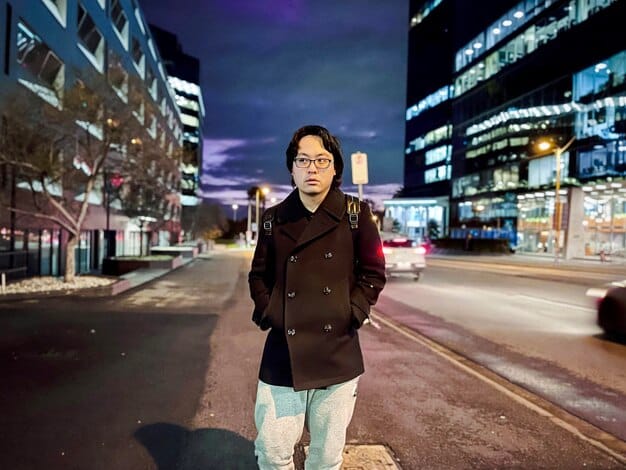K-Drama Second Lead Syndrome: Why We Fall for the Underdog and Storytelling Impact

The K-Drama second lead syndrome is a pervasive phenomenon where viewers are emotionally drawn to the secondary romantic interest, often finding themselves rooting for their unrequited love story over the main coupling, highlighting narrative complexities and audience empathy for character depth and vulnerability.
The K-Drama second lead syndrome: why we fall for the underdog and what it means for storytelling, is a unique and compelling phenomenon that transcends mere plot points, delving deep into the emotional psyche of viewers. This pervasive experience shifts our focus from the designated main couple, drawing us instead to the captivating journey of the second male or female lead, who often embodies resilience, sacrifice, and unrequited desires. It raises fascinating questions about character development, audience psychology, and the art of narrative construction itself.
understanding the second lead syndrome
The “second lead syndrome” in K-dramas is a term coined by fans to describe the phenomenon where viewers find themselves rooting for the secondary romantic interest more than the primary lead. This often happens because the second lead’s character arc, despite their unfulfilled romantic aspirations, is written with such depth and empathy that they become incredibly relatable and endearing. They embody a certain vulnerability and often display admirable qualities like loyalty, kindness, and self-sacrifice, which resonate deeply with audiences.
This syndrome isn’t just about romantic preference; it signifies a deeper engagement with the narrative. When we fall for the second lead, we’re acknowledging a complex interplay of character traits, plot devices, and emotional manipulation, all crafted by skillful writers. It’s a testament to the power of storytelling when a supporting character garners such fervent devotion, sometimes even overshadowing the designated protagonist.
the anatomy of the underdog
What makes these “underdog” characters so compelling? Often, it’s their inherent goodness and the often-tragic circumstances surrounding their unrequited love. They are frequently portrayed as genuinely good people who consistently put the happiness of others before their own, especially the person they love. This selflessness, coupled with their awareness that their love might never be reciprocated, creates a profound sense of pathos that draws viewers in.
- Unwavering Loyalty: Second leads often demonstrate unparalleled loyalty, whether to the female lead, their friends, or their principles.
- Genuine Kindness: Their actions are frequently driven by pure intentions, offering comfort and support without expecting anything in return.
- Quiet Suffering: They tend to endure their heartbreak in silence, adding a layer of tragic heroism to their portrayal.
Their struggles feel real, their hopes tangible, and their inevitable heartbreak palpable. This relatability is key to creating such a strong emotional connection, as audience members see reflections of their own experiences with unrequited love or difficult life choices in these characters. The second lead, despite being secondary, often carries the weight of universal human emotions.
narrative archetypes and their impact
Korean dramas frequently employ specific archetypes for their second leads, further solidifying their appeal. There’s the “Prince Charming” who is wealthy and sophisticated, the “Bad Boy with a Heart of Gold” who hides his kindness under a tough exterior, and the “Childhood Friend” who has loved the protagonist from afar for years. These archetypes are familiar, yet the writers infuse them with unique quirks and profound emotional depth.
The impact of these archetypes is significant because they tap into common romantic fantasies and societal expectations. The consistent portrayal of these characters as foils to the main lead, often highlighting their superior qualities in certain aspects, subtly influences viewer perception. The second lead thus becomes a symbol of what “could have been” or “should have been,” creating a delicious tension for the audience.
the pychology behind audience attachment
The psychological roots of the second lead syndrome are complex, intertwining empathy, identification, and a desire for justice. Viewers often identify with the second lead’s vulnerability and their experience of unrequited love, a universal human emotion. Their struggles resonate because many have experienced similar feelings of longing or rejection. This emotional mirroring creates a powerful bond.
Furthermore, there’s an inherent human tendency to side with the underdog. We are often drawn to characters who face overwhelming odds and yet continue to fight, even if their battle is for someone else’s happiness. The second lead, by virtue of their position, is always striving against the established “main pairing,” making their efforts inherently sympathetic.
empathy and the desire for justice
A significant factor is empathy. When we see a character consistently putting others first, sacrificing their own desires, and enduring heartbreak with grace, our inherent empathy is triggered. We want to see them happy, even if it’s not with the main lead. This desire for their happiness transforms into a desire for justice – a feeling that such a good person deserves a happy ending, irrespective of the plot’s primary romantic trajectory.
This dynamic also speaks to a human appreciation for effort and persistence. The second lead often works harder, waits longer, and endures more emotional pain, making their efforts seem more valuable. While the main couple’s love often feels fated or effortless, the second lead’s love is a testament to perseverance, which many viewers find admirable and deeply moving.
the thrill of the ‘what if’
Another psychological element is the “what if” factor. The second lead syndrome thrives on the fantasy of an alternative reality. What if the female lead chose the second lead? What if certain circumstances were different? This speculative thinking keeps viewers engaged, creating internal debates and fostering a deeper emotional investment in the characters’ fates. It mirrors our own contemplation of life’s missed opportunities and roads not taken.
This yearning for an alternative outcome also allows viewers to project their own ideals onto the narrative. If the main lead character has flaws or demonstrates traits that viewers find unappealing, the second lead often serves as a more ideal romantic partner, embodying desirable qualities that the main lead might lack. This creates a compelling internal conflict for the viewer.
The second lead’s distinct personality traits and narrative function often set them apart. They might be more mature, more emotionally available, or simply understand the protagonist better on a deeper level. This perceived compatibility, even if unacknowledged by the main character, further fuels the audience’s investment in their unrequited love story.
how the syndrome influences storytelling
The prevalence of the second lead syndrome has undoubtedly influenced K-drama storytelling. Writers are now more acutely aware of the emotional impact a well-developed second lead can have. This awareness often leads to more nuanced characterizations, ensuring that the second lead isn’t just a plot device but a fully fleshed-out individual with their own motivations, flaws, and strengths.
This evolving approach means that supporting romantic characters are no longer simply obstacles or background figures. They are often given significant screen time, intricate backstories, and emotional arcs that run parallel to the main narrative. This adds layers of complexity and richness to the overall story, making it more engaging for a discerning audience.
deepening character arcs
The need to create a compelling second lead often results in deeper and more complex character arcs for these individuals. Their journeys often involve significant personal growth, independent of their romantic pursuits. They might learn about self-love, develop resilience, or find new paths to happiness that don’t involve the main lead. This provides a more satisfying viewing experience, as these characters aren’t just defined by their romantic failure but by their individual development.
- Personal Growth: Many second leads mature significantly throughout the drama, learning valuable life lessons.
- Independent Happiness: Increasingly, second leads find contentment outside of the main romantic pairing, sometimes even with another character.
- Redefining Success: Their “failure” in love is often reframed as a success in terms of personal integrity and emotional strength.
This commitment to developing complete characters extends beyond the primary love triangles, impacting the quality of an entire drama. It encourages writers to think beyond conventional romantic tropes and explore the multifaceted nature of human relationships and personal growth.

the evolution of romantic tropes
The second lead syndrome challenges traditional romantic tropes by introducing a genuine alternative, one that often appears more emotionally mature or “right” to the audience. This forces writers to craft more compelling reasons for the main couple to end up together, moving beyond mere destiny or love-at-first-sight. It demands a more robust development of the core relationship to justify its ultimate success against such a strong contender.
Consequently, we see a shift in how main leads are portrayed. They must be equally endearing and complex to truly win the audience’s heart and not just the female lead’s. This elevates the overall quality of K-drama romances, pushing them beyond simplistic narratives into more nuanced explorations of love, choice, and personal connection. The rivalry is not just for the character’s affection, but for the audience’s as well.
common elements of second lead narratives
Several recurring elements contribute to the effectiveness of second lead narratives. These often include a “fated” connection with the main lead that is somehow thwarted, a consistent presence in the main lead’s life, and often a poignant “almost” moment that leaves both the character and the audience yearning for more. These elements are carefully woven into the fabric of the story to maximize emotional impact.
One prevalent element is the second lead’s undeniable chemistry with the main character. Even if the plot dictates a different outcome, that spark is often undeniable, making the choice harder for the characters and the audience. This chemistry complicates the narrative, adding a layer of realism to the emotional struggles, as love is rarely a clear-cut choice.
the ‘nice guy/girl’ trope
Often, the second lead embodies the “nice guy” or “nice girl” trope, who is unfailingly supportive, kind, and always there for the protagonist. While sometimes criticized for being one-dimensional, in K-dramas, this trope is often imbued with enough depth to make the character genuinely appealing. Their consistent goodness serves as a contrast to the main lead’s perhaps more turbulent or flawed personality, making the second lead seem like the safer, more comforting choice.
This consistent kindness often leads to a false sense of hope for the second lead. They are often portrayed as being aware of their role, yet they cling to the possibility of reciprocated love, making their eventual heartbreak even more impactful. It highlights the often-painful reality of unrequited love, where kindness isn’t always enough to win someone’s heart.
unresolved arcs and character fates
A crucial aspect of the second lead syndrome is the way their arcs are often resolved. While some find new love or a new purpose, many are left with unresolved romantic feelings, or their romantic fate is left ambiguous. This can be frustrating for viewers who invested deeply in their happiness, but it also reflects the often-messy reality of life and love, where not everyone gets a clear-cut happy ending. The lack of closure can further solidify their place in the viewer’s memory.
Sometimes, this lack of resolution sparks fan theories and discussions, extending the drama’s lifespan beyond its broadcast. Viewers actively debate alternative endings, write fan fiction, and express their continued support for the second lead, proving the enduring power of these characters even after the credits roll on the final episode. Their story continues to unfold in the minds of the audience.
This deliberate ambiguity in narrative resolution allows for a more realistic portrayal of love and personal growth. Not every journey ends with a neatly tied bow, and sometimes the most profound lessons are learned through unfulfilled desires. This artistic choice can deepen the audience’s appreciation for the nuances of life’s emotional landscape, resonating long after the final credits have rolled.
case studies: memorable second leads
Looking at specific examples illuminates the elements that elevate a second lead from a supporting role to a fan favorite. Characters like Han Ji-pyeong from “Start-Up,” Goo Jun-pyo (initially, from a certain perspective) from “Boys Over Flowers” (or rather, the consistently supportive Yoon Ji-hoo), or second female leads like Yoon Myung-joo from “Descendants of the Sun” have all captured hearts precisely because of their depth, unwavering affection, and often, tragic self-sacrifice.
Han Ji-pyeong, for instance, became a focal point because he genuinely wished for the protagonist’s success and happiness, even if it meant stepping aside. His silent support and subtle acts of kindness endeared him more than the bold declarations of the main lead. Similarly, Yoon Ji-hoo’s steadfast loyalty and quiet understanding offered a comforting presence in “Boys Over Flowers,” making him a beloved figure despite the strong main pairing.
the impact of “start-up”‘s han ji-pyeong
Perhaps one of the most talked-about second leads in recent memory is Han Ji-pyeong from “Start-Up.” His character embodies the epitome of the second lead syndrome: a self-made, successful man with a hidden soft side, who mentored the female lead and genuinely cared for her well-being. Viewers were torn, many arguing that his quiet support and emotional depth made him a more suitable partner than the main lead’s more erratic, though eventually successful, journey.
His storyline generated immense online discussion, with fans creating petitions and sharing impassioned arguments for why he deserved a happy ending with the female lead. This level of engagement showcases how a well-written second lead can ignite a fervent fanbase and sometimes even overshadow the intended narrative focus, pushing the boundaries of traditional romantic storytelling.
Moreover, Han Ji-pyeong’s character arc wasn’t solely defined by his romantic pursuit. He also underwent significant personal growth, learning to express himself emotionally and connect with others on a deeper level. This holistic development made him a more relatable and admirable figure, demonstrating that a character’s worth extends far beyond their romantic success. His journey was a masterclass in evolving character archetypes.
the evolving role of the second female lead
While the second lead syndrome often refers to male characters, second female leads also play a crucial role. Characters like Yoon Myung-joo in “Descendants of the Sun” captivate audiences with their strength, independence, and passionate dedication, even if their romantic journey is fraught with obstacles. Her fierce loyalty and determination made her pairing with the second male lead incredibly compelling, sometimes even more so than the main couple’s.
These female characters often challenge stereotypes, proving that “second leads” are not just defined by their romantic interests but by their powerful individual narratives. They add layers of complexity to the female friendships and rivalries within the drama, demonstrating ambition, resilience, and emotional depth that resonates strongly with viewers. Their stories often highlight the varied expressions of love and ambition in a patriarchal society.

the future of second lead narratives
As K-dramas continue to evolve and gain global popularity, the second lead syndrome will likely continue to shape storytelling. The demand for nuanced characters and emotionally rich narratives ensures that writers will continue to invest heavily in crafting compelling second leads. This could lead to even more experimental approaches, where the second lead might even find a fulfilling romantic path of their own, perhaps with another secondary character or an entirely new individual introduced later in the series.
This evolution also points to a growing audience sophistication. Viewers are no longer content with simplistic love triangles; they crave authenticity, emotional depth, and diverse representations of love and relationships. The second lead syndrome is a clear indicator that audiences are willing to invest emotionally in characters who defy conventional romantic tropes and offer a broader perspective on human connection.
beyond unrequited love
Future second lead narratives might move beyond the conventional trope of unrequited love, exploring different facets of their journeys. Perhaps they find happiness in self-discovery, career success, or unconventional relationships. This shift would provide a more realistic and empowering message, emphasizing that romantic love is not the sole determinant of a character’s worth or happiness. It would mark a significant departure from established romantic norms.
- Found Family: Second leads might find deep fulfillment in platonic relationships and chosen families.
- Career Focus: Their storylines could emphasize professional achievements and personal ambition over romantic pursuits.
- Self-Discovery: Narratives might focus on their journey of self-love and finding happiness independently.
By offering alternative pathways to contentment, K-dramas can broaden their appeal and provide more diverse representations of successful and happy lives, moving beyond the singular definition of a romantic happy ending. This would truly revolutionize the role of the second lead from a romantic foil to a protagonist of their own story, even within the confines of a larger ensemble narrative.
interactive storytelling and fan engagement
The intense fan engagement surrounding the second lead syndrome also points towards potential interactive storytelling elements in the future. While currently limited to online discussions and fan fiction, perhaps future dramas could incorporate audience feedback to influence secondary character arcs, offering alternative endings or spin-offs focused specifically on the beloved second leads. This would give an even greater voice to the passionate fan base.
This level of audience participation could deepen the emotional investment and loyalty to K-dramas, transforming passive viewing into an interactive experience. The power of the second lead syndrome lies not just in the characters themselves, but in the community and discussion they foster, creating a vibrant ecosystem around these compelling narratives. The future promises even more dynamic relationships between creators and viewers, fueled by these deep character affections.
| Key Aspect | Brief Description |
|---|---|
| 💔 Unrequited Love | Second leads often embody admirable traits despite loving in vain, creating audience empathy. |
| ✨ Character Depth | Their narratives are often richly developed, offering personal growth beyond romance. |
| 🤔 “What If” Factor | Viewers fantasize about alternative outcomes, fueling intense emotional investment. |
| 📈 Storytelling Impact | Influences writers to create more complex characters, challenging romantic tropes. |
frequently asked questions
▼
The second lead syndrome refers to the phenomenon where K-drama viewers develop a strong emotional attachment to the secondary romantic interest and root for them to end up with the main protagonist, even though the primary romantic pairing is already established. It’s driven by the second lead’s admirable qualities, unique charm, and often, their unrequited love story. This connection often stems from empathy for their struggle and sacrifice.
▼
Viewers often gravitate towards second leads due to their compelling character traits, such as loyalty, kindness, and selflessness. Their struggles resonate more deeply with audiences, often portraying a more realistic or vulnerable side of love. The “underdog” appeal and the inherent desire to see good people succeed, even in unrequited love, also contribute significantly to this emotional attachment and strong fan preference.
▼
The second lead syndrome has pushed K-drama writers to craft more complex and well-developed secondary characters. It encourages deeper character arcs, ensuring that second leads are not just plot devices but fully fleshed-out individuals. This trend challenges traditional romantic tropes, leading to more nuanced love triangles and demanding stronger development of the main romantic pairing to justify its eventual success against a beloved rival, enriching the genre.
▼
Yes, absolutely. While the term often emphasizes male second leads, second female leads can also evoke the syndrome. Characters who are strong, independent, and fiercely loyal, like Yoon Myung-joo from “Descendants of the Sun,” often capture audiences’ hearts. Their compelling individual storylines and often formidable presence can make viewers root for their romantic success or, at least, for their overall happiness, showing their independent allure.
▼
The future of second lead characters in K-dramas is likely to involve even more nuanced and diverse narratives. They might increasingly find happiness outside of the main romantic pairing, focusing on self-discovery, career success, or new romantic interests. This evolution reflects growing audience sophistication and a desire for more realistic and varied portrayals of growth and fulfillment beyond traditional romantic conclusions, further enhancing storytelling depth.
conclusion
The second lead syndrome is far more than a fleeting fan trend; it’s a profound testament to the power of empathetic storytelling and the complex relationship between characters and audience. By consistently delivering nuanced, kind, and often heartbroken individuals, K-dramas challenge conventional romantic narratives, enriching the genre with deeper emotional resonance and relatable human experiences. This phenomenon underscores a crucial lesson: sometimes, the most memorable heroes are those who love fully, even when their love remains unreciprocated, leaving an indelible mark long after the credits roll.





